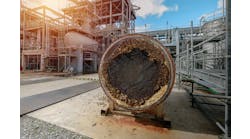Heat exchangers that use seawater are common worldwide because they provide a compelling benefit — seawater is a free heat-transfer medium that doesn’t produce emissions. The units exchange heat between a process fluid (cryogenic or hot) and seawater of ambient temperature. In warm sea conditions (i.e., water at >14°C or, better, >18°C), such a seawater stream can serve as the heat source in vaporizer/heater equipment. On the other hand, cold seawater (preferably <12°C) can handle cooling of hot process streams; even seawater in tropical climes might suffice to cool some process streams.
Many seawater heat exchangers are open-rack designs because they typically boast better economics and shorter payback periods than other options such as shell-and-tube units. This advantage holds particularly true for large high-flow and high-capacity equipment. Another key plus is that open-rack heat exchange is considered a very safe and reliable technology. The units provide a simple and cost-efficient heat exchange process that’s easy to operate and maintain. Plants usually use parallel operating exchangers with spares.
Mechanical Details
In an open-rack heat exchanger, the seawater enters at the top and runs downward in a film-like manner over tubes containing the process fluid. The seawater collects in a basin at the bottom of the tubes and then is returned to the sea.
Tubes are fabricated from suitable materials with proper thermal, mechanical, corrosion and erosion characteristics. For example, in cryogenic services (vaporizers/heaters), aluminum alloys nearly always are used.
The tubes require an appropriate coating (such as a zinc aluminum alloy one for aluminum alloys) to ward off different mechanisms of seawater corrosion and erosion. Typically spray applied, the coating usually serves as a sacrificial anode to protect the base material from corrosion by seawater. As a rough indication, such a coating should have an expected life of 25,000–50,000 total operating hours (say, 3–5 years) — but this depends on seawater quality and operation pattern as well as cleaning and maintenance work. For cheap coatings or poorly maintained open-rack exchangers, recoating should take place every one or two years, particularly when polluted seawaters are involved. As a very rough estimate, a 2-block 200-t/h unit takes 2–3 weeks, excluding preparation period, to recoat.
Tubes usually have fins to increase heat transfer area. In addition, the inside of each tube most often has a cruciate profile, spirally twisted and fixed through the entire length, or another arrangement to further enhance heat transfer. Such a structure promotes turbulent flow, which improves heat exchange.
The tubes are arranged in panels. Each panel generally holds close to a hundred heat-transfer tubes. The distance between the panels often is 550–700 mm. Several of these panels (say, four to eight) are unified into a block by a manifold pipe and hung from a ceiling frame placed over a concrete structure at the installation site. A slide-type support provided under the block absorbs thermal movements. Increasing or decreasing the number of panels or blocks easily allows a design appropriate for the necessary heating/cooling capacity.
Often, it’s possible to isolate each block individually using proper valving systems. For instance, a 3-block design might operate only one or two blocks at low turndown. However, some manufacturers recommend using all blocks for part-load.
The units require regular inspections and maintenance to keep the finned tube surface clean. So, it’s important to ensure the seawater distribution facility over the heat exchanging panels is easily accessible, adjustable and designed to permit cleaning, via methods such as a high-pressure water jet or a rodding brush.
Although the design might seem simple, some components need great care and proper choice. For example, the type of connection for the process fluid inlet to the equipment is critical because this point experiences the highest thermal gradient (temperature difference) at startup.
Ideally, opt for flange connections instead of transition joints; for maintenance and panel re-coating (if you don’t plan on in-situ recoating), choose panels that are removable without cutting . Flange leakage at the inlet for very low or very high temperature applications usually is a concern. In such cases, consider the use of a one or two class higher ASME flange or any other suitable alternative to eliminate the potential leakage.
Many open-rack heat exchangers for cryogenic or very hot temperature are designed with a weld connection using a transition joint between the inlet piping and the pressure part of the exchanger (which usually are made from dissimilar materials) because of fast rampup requirements at startup. However, the design and fabrication of a successful transition joint to weld dissimilar metals are complex and difficult tasks.
Installations usually include standby units, with an “N+1” (one operating exchanger and one spare) or “N+2” (two spares) configuration common. Plants requiring high reliability and availability usually opt for a N+2 arrangement. You should maintain standby exchangers in operating condition, ready for startup when required.
Avoiding Problems
The exchanger should operate stably, reliably and safely without any vibration or problem within its specified operating range. You usually should expect the manufacturer to guarantee continuous operation from 10% to 110% of capacity. Some open-rack units have experienced high vibration during transient or part-load operation. So, consider studies and proper measures to avoid high vibration when operating under transient conditions and within the entire part-load range.
To prevent induced vibration, reinforce the support of the piping around equipment (upstream and downstream) to increase the natural frequency above the typical 10 or 12 Hz. In addition, these applications always benefit from high-stiffness piping designs. Of course, accurate simulations and dynamic studies are the best ways to determine potential risks of component failure from vibration, fatigue from thermal cycling and other damage mechanisms.
Operation in very cold or very hot applications often results in complex phenomena such as the icing of seawater (for cryogenic applications) or the boiling of seawater (for hot fluids) on the external surface of the initial section of tubes (where the maximum temperature difference exists). This can cause difficulties in design, mechanical analysis and operation. Because the heat exchanger usually handles a significant difference in temperature and needs a rapid startup or shutdown, thermal stresses and transient operations require appropriate consideration. A variety of studies (such as those by finite element methods) and tests can lead to highly durable structures. Today’s methods enable design of the most suitable tubes (e.g., sizes and internal/external surface shapes). Design pressures of 50, 75 or 100 barg or more aren’t uncommon for such exchangers.
A stress analysis can ensure a design provides proper flexibility and minimizes loads on panel connections and other critical components. Most often, the magnitudes of thermal stresses depend on the deformation of the inlet header, which has a higher cross-sectional rigidity than that of the heat transfer tubes. Based on different studies and observations, maximum thermal stresses often appear during peak running and immediately after process fluid flow is stopped. Thermal stresses at welded (including transition) joints and heat affected zones of heat transfer tubes should remain within allowable limits.
You also must consider possible thermal stresses of the panels due to different malfunction scenarios. For instance, poor seawater distribution can result in some unexpected thermal stresses. So, finite element studies for the panel design to check the stresses at the transition joints and headers usually are needed.
Modern Designs
During operation, the highest tube temperature gradient occurs on the outer wall at the initial part of each tube. As already noted, in vaporizer/heater units, the temperature could be lower than the freezing point of seawater, prompting ice buildup on the tubes. Especially in cold climates, the ice thickness and height could increase significantly, causing substantial resistance to heat transfer. On the other hand, for open-rack coolers, the temperature might exceed the boiling point of seawater. Use advanced designs to avoid this icing/boiling problem and the ensuing degraded performance.
Some manufacturers have developed duplex pipe structures at the initial part of tubes to suppress icing/boiling on the outer surface of the tube. The process fluid feeds into both an inner tube section and annular channel between inner and outer sections of the tube. The process fluid’s flow rate in the inner tube usually equals that in the annular channel. Inside the annular channel, process fluid directly exchanges heat with the seawater. However, because of lower mass rates, this doesn’t cause thermal shock and boiling/freezing. Meanwhile, process fluid in the inner tube exchanges heat with the fluid in the annular channel. These gradual heat exchanges allow better control of temperature and prevent ice forming or boiling on the surface of the heat transfer tube.
Modern duplex pipe structures provide significantly improved thermal performance; they reduce the volume of seawater required by 10–15%. In addition, they decrease area requirements to 30–45% of those of conventional exchangers, and cut operating cost by 10–20%.
The Seawater Side
The steel frame and all surfaces in contact with seawater require proper material selection and coating. Usually this means choice of an appropriate grade of stainless steel. For some applications with “clean” seawater, duplex or other common stainless steels suffice. Other applications relying on polluted or dirty seawater demand better materials such as super duplex stainless steels.
It’s sensible to install side panels to prevent any projection of seawater to the outside of the equipment.
To control algae growth within the system, inject sodium hypochlorite, chlorine or similar chemicals into the seawater before it passes to the exchanger.
Seawater contamination and pollution can degrade the operation and reliability of the exchangers. For instance, seawater containing significant amounts of heavy metal ions can shorten the life of the protective coating of tubes; the metal ions attack such coatings. Seawater loaded with sand and suspended solids can lead to sediment jamming the water trough and the tube panel. The design of the seawater intake filtration system should prevent silts, sands and sea life from reaching the seawater pumps and exchangers. (For an unusual case of exchanger plugging, see “Don’t Neglect Spring Cleaning Duties.”)
You also must consider the impact of the unit on marine life. The large volumes of seawater used could have an adverse effect. In addition, the cooled/heated and treated seawater discharged back to the source potentially could impair marine life and overall seawater quality. Any open-rack heat exchanger system also poses several minor environmental issues, including seawater intake and seawater outfall. Improper design could prompt a major breach of environmental rules with serious consequences. Good design can forestall such issues. Seawater discharge temperature should comply with local regulation; most jurisdictions limit the temperature change to 5°C or 10°C. Also, pay attention to the locations of the seawater intake and outfall to avoid cold/hot seawater recirculation.
A Case Study
A plant needed a 400-t/h capacity open-rack vaporizer for a cryogenic service. This led to a design that uses 90 tubes per panel, four panels per block, and four blocks per unit. Each panel block has a capacity of 100 t/h. Normal inlet pressure of the cryogenic liquid to this vaporizer is around 48 barg. The design pressure is considered 80 barg. The vaporizer requires around 8,000 t/h of seawater. As a rough indication, the estimated heat exchanged is 90 MW. In other words, this open-rack vaporizer system is a massive unit to exchange 90 MW.
Empty weight of each panel block is around 8 t; empty weight of the equipment unit with the four blocks and including manifolds, headers, seawater troughs, inner maintenance deck, etc., is approximately 65 t. Operating weight of the unit is around 110 t.
AMIN ALMASI is a mechanical consultant based in Sydney, Australia. Email him at [email protected].

